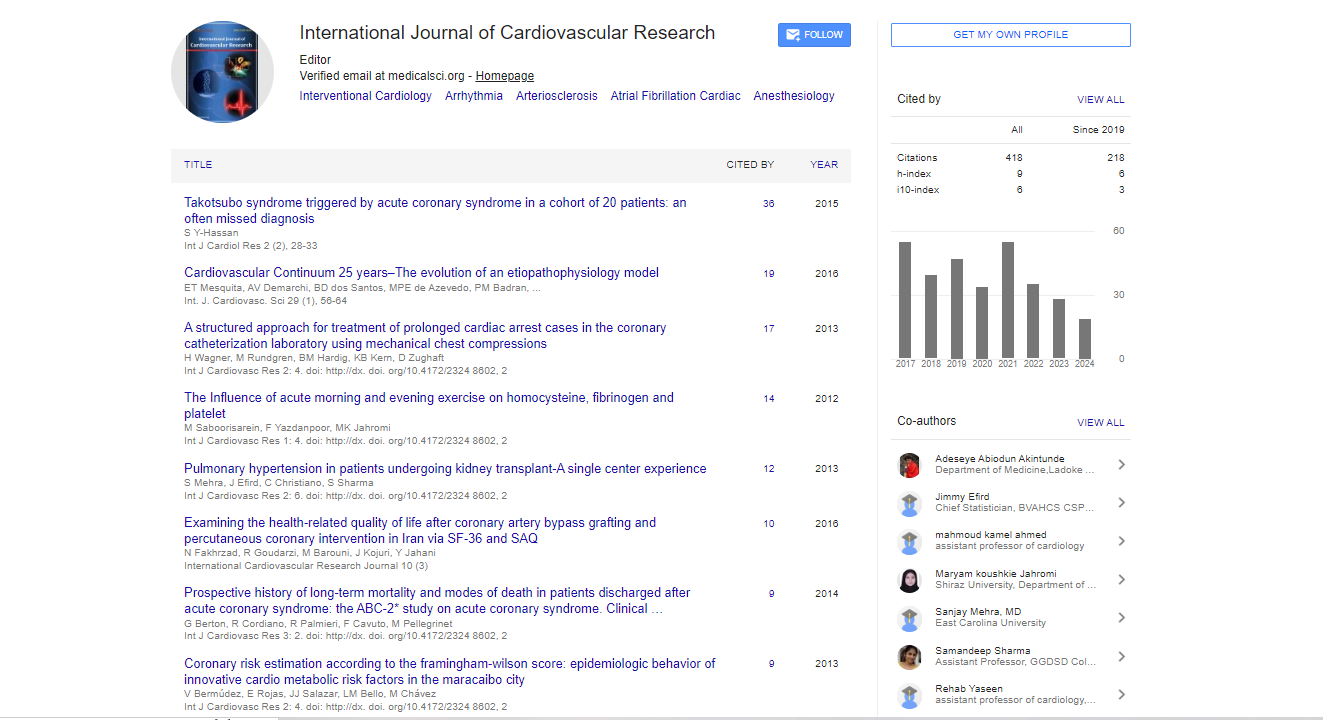Perspective, Int J Cardiol Res Vol: 13 Issue: 4
Advancing Diagnostics and Patient Care with Cardiac Imaging Technologies
Jessica Taylor*
1Department of Cardiovascular Medicine, Perelman School of Medicine, Pennsylvania, United States of America
*Corresponding Author: Jessica Taylor,
Department of Cardiovascular Medicine,
Perelman School of Medicine, Pennsylvania, United States of America
E-mail: jessica.taylor@pennmedicine.upenn.edu
Received date: 15 July, 2024 Manuscript No. ICRJ-24-149292;
Editor assigned date: 17 July, 2024, PreQC No. ICRJ-24-149292 (PQ);
Reviewed date: 31 July, 2024, QC No. ICRJ-24-149292;
Revised date: 07 August, 2024, Manuscript No. ICRJ-24-149292 (R);
Published date: 14 August, 2024, DOI: 10.4172/2324-8602.1000576
Citation: Taylor J (2024) Advancing Diagnostics and Patient Care with Cardiac Imaging Technologies. Int J Cardiol Res 13:4.
Description
Cardiac imaging is one of the most important components in diagnosing and managing Cardiovascular Diseases (CVD), which remain the leading cause of morbidity and mortality globally. Over the last few decades, advances in imaging technologies have significantly improved the ability to visualize the heart's structure and function in real time. As medical study continues to evolve, the future of cardiac imaging promises even greater accuracy, less invasiveness, enhanced computational techniques and personalized approaches to diagnosis and treatment. One of the most exciting trends in the future of cardiac imaging is the integration of Artificial Intelligence (AI) and Machine Learning (ML) into imaging processes. AI algorithms are now being developed to assist with image acquisition, interpretation and even diagnosis. AI has the potential to revolutionize image interpretation, providing more accurate, faster and consistent readings than human operators. For example, AI based algorithms can be trained to recognize patterns in echocardiographic or Magnetic Resonance Imaging (MRI) images, detecting abnormalities such as hypertrophic cardiomyopathy, valve dysfunctions, or myocardial infarction with greater precision than traditional methods. Automated segmentation of cardiac structures, such as the left ventricle and atria, is already reducing human error and saving time in clinical workflows.
Beyond diagnostics, AI holds promise for predictive modeling in cardiac imaging. By analyzing large datasets of imaging studies combined with clinical information, AI can help predict the likelihood of future cardiac events. For instance, machine learning models can analyze Coronary CT Angiography (CCTA) data to assess plaque composition and predict the risk of acute coronary syndrome. This kind of risk stratification can enable more personalized treatment plans and earlier interventions. Emerging technologies are expanding the possibilities of cardiac imaging, offering non-invasive, highresolution and functional insights that were once unachievable. Two such modalities are photon-counting CT and ultrafast MRI. Photon- Counting Computed Tomography (PCCT) is a transformative upgrade to traditional CT. Unlike conventional CT scanners, which measure the total energy of X-rays, PCCT can detect individual photons and their energy levels. This capability allows for higher resolution images with lower radiation doses and enhanced tissue characterization. Early studies have shown that PCCT can better differentiate between calcium deposits in arteries and soft plaques, improving the detection of CAD and the accuracy of coronary risk assessments.
Magnetic resonance imaging has long been a gold standard for assessing cardiac function, but the technique has been limited by long scan times, especially for patients with arrhythmias or difficulty holding their breath. Recent advancements in ultrafast MRI are addressing these limitations by significantly reducing imaging time without sacrificing image quality. Techniques like compressed sensing and parallel imaging allow the acquisition of entire heart cycles in a fraction of the time. This development not only enhances patient comfort but also makes MRI feasible for more acute care settings, where rapid imaging is important. Another promising future direction is molecular imaging, which aims to visualize molecular and cellular processes in the heart in real-time. By using targeted tracers, studiers can observe cellular events like inflammation, apoptosis, or fibrosis, long before structural abnormalities become visible. This early detection could revolutionize the management of conditions like atherosclerosis, allowing clinicians to intervene before irreversible damage occurs. Hybrid imaging modalities, which combine two or more imaging techniques, are poised to become a cornerstone of future cardiac diagnostics. These approaches harness the strengths of multiple technologies to provide comprehensive data in a single examination. Positron Emission Tomography (PET) combined with MRI or CT represents a powerful hybrid imaging technique. PET provides metabolic and molecular information, while CT or MRI offers high-resolution anatomical detail. In cardiology, PET-MRI is especially promising for evaluating myocardial viability, inflammation and perfusion. For example, it can simultaneously assess the metabolic activity of cardiac cells and the extent of fibrosis giving a holistic view of heart health in patients with heart failure or myocarditis. While less common, combinations of ultrasound with CT or MRI are emerging as non-invasive ways to assess heart function in real time. The integration of functional information from ultrasound with structural data from CT or MRI may prove invaluable in complex cases like congenital heart disease or in the evaluation of cardiac tumors.
Conclusion
The future of cardiac imaging technologies holds immense promise, from the integration of AI and machine learning to the development of hybrid and molecular imaging modalities. These innovations are poised to improve diagnostic accuracy, reduce invasiveness and enable personalized treatment plans for patients with cardiovascular diseases. However, several challenges remain. The cost of implementing new technologies, the need for specialized training and ensuring equitable access to advanced imaging across healthcare settings are significant obstacles. Additionally, with the advent of AI driven diagnostics, ethical considerations regarding the role of AI in decision making and patient care must be addressed. Despite these challenges, the trajectory of cardiac imaging is one of continuous improvement. As these technologies advance, they will undoubtedly enhance clinicians' ability to diagnose, treat and prevent cardiovascular disease, ultimately improving patient outcomes and saving lives.
 Spanish
Spanish  Chinese
Chinese  Russian
Russian  German
German  French
French  Japanese
Japanese  Portuguese
Portuguese  Hindi
Hindi 



